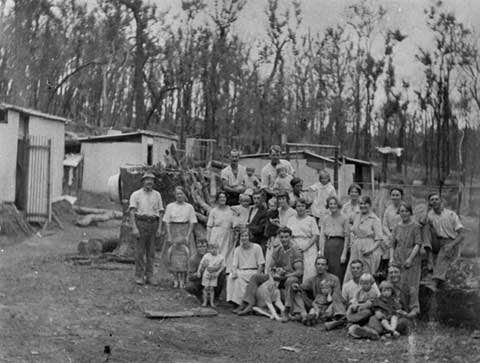Group Settlement
The 1922 British Empire Settlement Act detailed a migration scheme in which Britain and Australia would share the costs of migrants’ passages, settlement schemes and associated public works. Western Australia had proposed what became known as the Group Settlement Scheme. Settlers were to work in groups of 20 to develop a number of dairy farms and be paid for their work. Later each would take on a farm when it was ready for dairying. Western Australia undertook to settle 6,000 families on farms and take 75,000 immigrants. £1,000 was the estimated cost of developing each farm.

Group 105 Kentdale 1924
The Group Settlement Scheme began in 1921 with groups in the Manjimup district, followed by others between Busselton and Augusta, at Denmark, Northcliffe and the Peel Estate south of Perth. The scheme soon ran into trouble and by 1925 was the subject of a Royal Commission. Only 2,442 farms out of the proposed 6,000 were ever developed and costs proved to be about £3,000 per farm plus costs for public works. The scheme became a social and financial tragedy, especially when the Depression in the 1930's reduced the prices of primary produce. The loss to the state over the scheme was £6,500,000.
Jack Gabbedy's Group Settlement parts 1 & 2 (994.104 GAB) provides excellent background reading for the history of the scheme. The Lands and Surveys Department files on individual leases have not survived. However, the Department of Land Administration holds a nominal card index which enables a researcher to identify the leases held by these settlers. This card index is arranged alphabetically and tracks all land actions by an individual, and relates file numbers to those actions. Thus, it is possible through this index, to locate all land held by any person until the late 1980's. It is commonly referred to as the Dead Names Index as it ceased in the late 1980's when the information was recorded on a computer database. Please note that these cards are not in strict alphabetical order and it may be necessary to search through a number of cards either side of where the name should have appeared. The index is on microfiche and is part of the State Records Office collection.
Some records which may be of interest are:
CONS 724/1-12: Lands and Survey Department. Monthly reports of some groups 1923-1931 (Groups 43-45, 47, 61, 65-69, 74-75) and files concerning particular settlers 1923-1932.
CONS 4890/1: Lands and Surveys Department. Register of Applications for Group Settlement 1930
Records 1035 Group Settlement applications in 1930. Details include application number, date of application, name of applicant, acreage applied for, district and location/lot number, date deed issued and a reference to the relevant department file.
CONS 6160/CD151-CD275
Once housed in the Battye Library (ex 426C), this is a series of maps showing the block location numbers, land cleared, uncleared, under cultivation and details of improvements for Groups 1-150 (excepting 37, 41, 58, 71, 79-80, 82-85, 94, 99, 107, 113-114, 129-130, 134, 136-137).
The National Archives of Australia has several records which will show the names of group settlers. Simply enter their website and enter the keywords group settlement western australia in the Keywords search box. You will notice many of the records displayed have been digitised and it may be that they will all contain information on group settlers.
Of especial interest are those records noted as X22/5 Parts 1 & 3, which contain lists of group settlers and provide the following information: part 1 has an alphabetical list of group settlers showing name, marital statues, dated sailed, ship, number of people in family, date placed on group, group and location number, on original holding or transferred, remarks (usually date of leaving group) and also a return of holdings arranged in group number order showing occupants, improvements effected and expenditure; part 3 has an alphabetical list by area showing name, marital status, date sailed, ship, group and location number and remarks.
The Post Office Directories have, at the end of the town sequence, a listing of the group settlements and the men on them, covering 1923-1947.
